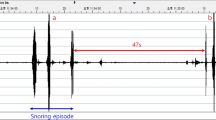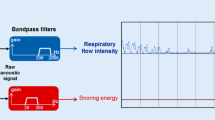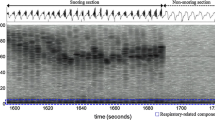Abstract
Purpose
Loud snoring is one of the principle symptoms of obstructive sleep apnea (OSA). Snoring sound analysis is a potentially cost-effective, reliable alternative for the diagnosis of OSA. However, no investigation has determined the accuracy of snoring signal analysis for the diagnosis of OSA in the Chinese Han population. Therefore, we investigated whether whole-night snoring detection and analysis aids the diagnosis of OSA using a new snore analysis technique.
Methods
Snoring sounds were recorded using a non-contact microphone and polysomnography (PSG) was performed simultaneously throughout the night. We randomly selected 30 subjects each from four groups based on the severity of OSA. The rhythm and frequency domain of the snoring signal were analyzed based on frequency energy endpoint detection (FEP) and the Earth mover’s distance (EMD), for each subject to harvest the EMD-calculated Apnea-Hypopnea Index (AHIEMD). Finally, we compared the AHIEMD with the PSG-monitored AHI (AHIPSG).
Results
The accuracy of the AHIEMD compared with the AHIPSG was 96.7, 86.7, 86.7, and 96.7 % in non-, mild, moderate, and severe OSA patients, respectively. AHIEMD was correlated with AHIPSG (r 2 = 0.950, p < 0.001). The area under the receiver operating characteristic curve values for OSA detection was 0.974, 0.957, and 0.997 for AHIEMD thresholds of 5, 15, and 30 events/h, respectively. Bland–Altman analysis revealed 91.7 % agreement of AHIEMD with AHIPSG.
Conclusions
This new method for identifying OSA by analyzing snoring is feasible and reliable in the Han population. The snoring sound-based technique appears to be a promising tool for OSA screening and diagnosis.





Similar content being viewed by others
References
Young T, Palta M, Dempsey J, Skatrud J, Weber S, Badr S (1993) The occurrence of sleep-disordered breathing among middle-aged adults. N Engl J Med 32:1230–1235
Bagai K (2010) Obstructive sleep apnea, stroke, and cardiovascular diseases. Neurologist 16:329–339
Kasai T, Floras JS, Bradley TD (2012) Sleep apnea and cardiovascular disease: a bidirectional relationship. Circulation 126:1495–1510
Lam JC, Mak JC, Ip MS (2012) Obesity, obstructive sleep apnoea and metabolic syndrome. Respirology 17:223–236
Lal C, Strange C, Bachman D (2012) Neurocognitive impairment in obstructive sleep apnea. Chest 141:1601–1610
Marcus CL, Brooks LJ, Draper KA, Gozal D, Halbower AC, Jones J et al (2012) Diagnosis and management of childhood obstructive sleep apnea syndrome. Pediatrics 130:e714–e755
Ghegan MD, Angelos PC, Stonebraker AC, Gillespie MB (2006) Laboratory versus portable sleep studies: a meta-analysis. Laryngoscope 116:859–864
Solà-SolerJ FJA, Morera J, Jané R (2011) Bayes classification of snoring subjects with and without sleep apnea hypopnea syndrome, using a Kernel method. Conf Proc IEEE Eng Med Biol Soc 2011:6071–6074
Huang SG, Li QY; Sleep Respiratory Disorder Study Group Respiratory Disease Branch Shanghai Medical Association (2003). Prevalence of obstructive sleep apnea-hypopnea syndrome in Chinese adults aged over 30 year in Shanghai. Zhonghua Jie He He Hu Xi Za Zhi 26:268–272. Chinese.
Zhang Q, He QY, Du QY, Pang GF, Zhao LS, Wu RQ, Han F, Liu LC, Wang Y, Sun GX, Liu XY, Zhao ZW (2003). Epidemiologic study on sleep apnea-hypopnea syndrome by home investigation in Chengde City. Zhonghua Jie He He Hu Xi Za Zhi 26:273–275. Chinese.
Pevernagie D, Aarts RM, Meyer MD (2010) The acoustics of snoring. Sleep Med Rev 14:131–144
Wilson K, Stoohs RA, Mulrooney TF, Johnson LJ, Guilleminault C, Huang Z (1999) The snoring spectrum: acoustic assessment of snoring sound intensity in 1,139 individuals undergoing polysomnography. Chest 115:762–770
Herzog M, Schmidt A, Bremert T, Herzog B, Hosemann W, Kaftan H (2008) Analysed snoring sounds correlate to obstructive sleep disordered breathing. Eur Arch Otorhinolaryngol 265:105–113
Fiz JA, Jané R, Solà-Soler J, Abad J, García MA, Morera J (2010) Continuous analysis and monitoring of snores and their relationship to the apnea-hypopnea index. Laryngoscope 120:854–862
Maimon N, Hanly PJ (2010) Does snoring intensity correlate with the severity of obstructive sleep apnea? J Clin Sleep Med 6:475–478
Lee LA, Yu JF, Lo YL, Chen YS, Wang DL, Cho CM et al (2012) Energy types of snoring sounds in patients with obstructive sleep apnea syndrome: a preliminary observation. PLoS ONE 7:e53481
American Academy of Sleep Medicine (2005) The International Classification of Sleep Disorders: diagnostic and coding manual, 2nd ed. Westchester, IL: American Academy of Sleep Medicine, 165-167
Ohayon MM, Guilleminault C, Priest RG, Caulet M (1997) Snoring and breathing pauses during sleep: telephone interview survey of a United Kingdom population sample. BMJ 314:860–863
Hoffstein V, Mateika S, Anderson D (1994) Snoring: is it in the ear of the beholder? Sleep 17:522–526
Whyte KF, Allen MB, Jeffrey AA, Gould GA, Douglas NJ (1989) Clinical features of the sleep apnoea/hypopnoea syndrome. Q J Med 72:659–666
Ulualp SO (2010) Snoring and obstructive sleep apnea. Med Clin North Am 94:1047–1055
Esnaola S, Durán J, Infante-Rivard C, Rubio R, Fernández A (1996) Diagnostic accuracy of a portable recording device (MESAM IV) in suspected obstructive sleep apnoea. Eur Respir J 9:2597–2605
Van Brunt DL, Lichstein KL, Noe SL, Aguillard RN, Lester KW (1997) Intensity pattern of snoring sounds as a predictor for sleep-disordered breathing. Sleep 20:1151–1156
Cirignotta F, Mondini S, Gerardi R, Mostacci B, Sancisi E (2001) Unreliability of automatic scoring of MESAM 4 in assessing patients with complicated obstructive sleep apnea syndrome. Chest 119:1387–1392
Ben-Israel N, Tarasiuk A, Zigel Y (2010) Nocturnal sound analysis for the diagnosis of obstructive sleep apnea. Conf Proc IEEE Eng Med Biol Soc 2010:6146–6149
Abeyratne UR, Wakwella AS, Hukins C (2005) Pitch jump probability measures for the analysis of snoring sounds in apnea. Physiol Meas 26:779–798
Fiz J, Abad J, Jané R, Riera M, Mañanas MA, Caminal P, Rodenstein D, Morera J (1996) Acoustic analysis of snoring sound in patients with simple snoring and obstructive sleep apnoea. Eur Respir J 9:2365–2370
Ng AK, Koh TS, Baey E, Lee TH, Abeyratne UR, Puvanendran K (2008) Could formant frequencies of snore signals be an alternative means for the diagnosis of obstructive sleep apnea? Sleep Med 9:894–898
Ng AK, Koh TS, Abeyratne U, Puvanendran K (2009) Investigation of obstructive sleep apnea using nonlinear mode interactions in nonstationary snore signals. Ann Biomed Eng 37:1796–1806
Mesquita J, Solà-Soler J, Fiz JA, Morera J, Jané R (2012) All night analysis of time interval between snores in subjects with sleep apnea hypopnea syndrome. Med Biol Eng Comput 50:373–381
Karunajeewa AS, Abeyratne UR, Hukins C (2011) Multi-feature snore sound analysis in obstructive sleep apnea-hypopnea syndrome. Physiol Meas 32:83–97
Acknowledgments
This study was supported by grants-in-aid from science and technical committee of Shanghai in China (07JC14029) and Shanghai Shen-kang Hospital management center project of Shanghai (SHDC12010209).
Conflict of interest
No conflict of interest was declared.
Author information
Authors and Affiliations
Corresponding authors
Additional information
Huajun Xu and Wei Song contribute equally to this article.
Rights and permissions
About this article
Cite this article
Xu, H., Song, W., Yi, H. et al. Nocturnal snoring sound analysis in the diagnosis of obstructive sleep apnea in the Chinese Han population. Sleep Breath 19, 599–605 (2015). https://doi.org/10.1007/s11325-014-1055-0
Received:
Revised:
Accepted:
Published:
Issue Date:
DOI: https://doi.org/10.1007/s11325-014-1055-0




